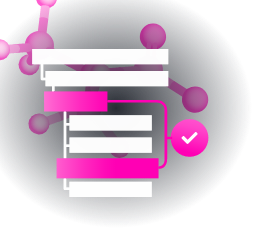Identification
- Summary
-
Lomefloxacinis a fluoroquinolone used to prevent and treat a wide variety of infections in the body.
- Brand Names
-
Maxaquin
- Generic Name
- Lomefloxacin
- DrugBank Accession Number
- DB00978
- Background
-
Lomefloxacin氟喹诺酮类抗生素,使用to treat bacterial infections including bronchitis and urinary tract infections (UTIs). Additionally, it has been employed for the prophylaxis of UTIs prior to surgery as well.
- Type
- Small Molecule
- Groups
- Approved, Investigational
- Structure
- Weight
-
Average: 351.3479
Monoisotopic: 351.139447899 - Chemical Formula
- C17H19F2N3O3
- Synonyms
-
- (±)-1-ethyl-6,8-difluoro-1,4-dihydro-7-(3-methyl-1-piperazinyl)-4-oxo-3-quinolinecarboxylic acid
- 1,4-Dihydro-6,8-difluoro-1-ethyl-7-(3-methyl-1-piperazinyl)-4-oxo-3-quinolinecarboxylic acid
- LFLX
- Lomefloxacin
- Lomefloxacine
- Lomefloxacino
- Lomefloxacinum
Pharmacology
- Indication
-
For the treatment of bacterial infections of the respiratory tract (chronic bronchitis) and urinary tract, and as a pre-operative prophylactic to prevent urinary tract infection caused by:S.pneumoniae,H.influenzae,S.aureus,P.aeruginosa,E. cloacae,P. mirabilis,C. civersus,S. asprphyticus,E.coli, andK.pneumoniae.
 Reduce drug development failure ratesBuild, train, & validate machine-learning models
Reduce drug development failure ratesBuild, train, & validate machine-learning models
with evidence-based and structured datasets.Build, train, & validate predictive machine-learning models with structured datasets. - Associated Conditions
- Contraindications & Blackbox Warnings
-
 Avoid life-threatening adverse drug eventsImprove clinical decision support with information oncontraindications & blackbox warnings, population restrictions, harmful risks, & more.Avoid life-threatening adverse drug events & improve clinical decision support.
Avoid life-threatening adverse drug eventsImprove clinical decision support with information oncontraindications & blackbox warnings, population restrictions, harmful risks, & more.Avoid life-threatening adverse drug events & improve clinical decision support. - Pharmacodynamics
-
Lomefloxacin is a fluoroquinolone antibiotic used to treat chronic bronchitis, as well as complicated and uncomplicated urinary tract infections. It is also used as a prophylactic or preventative treatment to prevent urinary tract infections in patients undergoing transrectal or transurethral surgical procedures. Flouroquinolones such as lomefloxacin possess excellent activity against gram-negative aerobic bacteria such asE.coliandNeisseria gonorrhoeaas well as gram-positive bacteria includingS. pneumoniaeandStaphylococcus aureus. They also posses effective activity against shigella, salmonella, campylobacter, gonococcal organisms, and multi drug resistant pseudomonas and enterobacter.
- Mechanism of action
-
Lomefloxacin is a bactericidal fluoroquinolone agent with activity against a wide range of gram-negative and gram-positive organisms. The bactericidal action of lomefloxacin results from interference with the activity of the bacterial enzymes DNA gyrase and topoisomerase IV, which are needed for the transcription and replication of bacterial DNA. DNA gyrase appears to be the primary quinolone target for gram-negative bacteria. Topoisomerase IV appears to be the preferential target in gram-positive organisms. Interference with these two topoisomerases results in strand breakage of the bacterial chromosome, supercoiling, and resealing. As a result DNA replication and transcription is inhibited.
Target Actions Organism ADNA gyrase subunit A inhibitorHaemophilus influenzae (strain ATCC 51907 / DSM 11121 / KW20 / Rd) ADNA topoisomerase 4 subunit A inhibitorHaemophilus influenzae (strain ATCC 51907 / DSM 11121 / KW20 / Rd) UDNA topoisomerase 2-alpha inhibitorHumans - Absorption
-
Rapid and nearly complete with approximately 95% to 98% of a single oral dose being absorbed.
- Volume of distribution
-
Not Available
- Protein binding
-
10%
- Metabolism
-
Minimally metabolized although 5 metabolites have been identified in human urine. 65% appears as the parent drug in urine and 9% as the glucuronide metabolite.
- Route of elimination
-
The urinary excretion of lomefloxacin was virtually complete within 72 hours after cessation of dosing, with approximately 65% of the dose being recovered as parent drug and 9% as its glucuronide metabolite.
- Half-life
-
8 hours
- Clearance
-
- 271 mL/min/1.73 m2 [creatinine clearance of 110 mL/min/1.73 m2]
- 31 mL/min/1.73 m2 [creatinine clearance of 0 mL/min/1.73 m2]
- Adverse Effects
-
 Improve decision support & research outcomesWith structured adverse effects data, including:blackbox warnings, adverse reactions, warning & precautions, & incidence rates.Improve decision support & research outcomes with our structured adverse effects data.
Improve decision support & research outcomesWith structured adverse effects data, including:blackbox warnings, adverse reactions, warning & precautions, & incidence rates.Improve decision support & research outcomes with our structured adverse effects data. - Toxicity
-
Adverse reactions include peripheral neuropathy, nervousness, agitation, anxiety, and phototoxic events (rash, itching, burning) due to sunlight exposure.
- Pathways
- Not Available
- Pharmacogenomic Effects/ADRsBrowse all" title="" id="snp-actions-info" class="drug-info-popup" href="javascript:void(0);">
- Not Available
Interactions
- Drug InteractionsLearn More" title="" id="structured-interactions-info" class="drug-info-popup" href="javascript:void(0);">
-
This information should not be interpreted without the help of a healthcare provider. If you believe you are experiencing an interaction, contact a healthcare provider immediately. The absence of an interaction does not necessarily mean no interactions exist.
Drug Interaction Integrate drug-drug
interactions in your softwareAbametapir The serum concentration of Lomefloxacin can be increased when it is combined with Abametapir. Abatacept The metabolism of Lomefloxacin can be increased when combined with Abatacept. Abiraterone The serum concentration of Lomefloxacin can be increased when it is combined with Abiraterone. Acarbose The therapeutic efficacy of Acarbose can be increased when used in combination with Lomefloxacin. Aceclofenac Aceclofenac may increase the neuroexcitatory activities of Lomefloxacin. Acemetacin Acemetacin may increase the neuroexcitatory activities of Lomefloxacin. Acenocoumarol 苊香豆醇可以我的治疗效果ncreased when used in combination with Lomefloxacin. Acetaminophen The metabolism of Lomefloxacin can be decreased when combined with Acetaminophen. Acetohexamide The therapeutic efficacy of Acetohexamide can be increased when used in combination with Lomefloxacin. Acetylsalicylic acid Acetylsalicylic acid may increase the neuroexcitatory activities of Lomefloxacin.  Identify potential medication risksEasily compare up to 40 drugs with our drug interaction checker.Get severity rating, description, and management advice.Learn more
Identify potential medication risksEasily compare up to 40 drugs with our drug interaction checker.Get severity rating, description, and management advice.Learn more - Food Interactions
-
- Avoid multivalent ions. Separate the administration polyvalent ions, including magnesium and aluminum-containing antacids, from lomefloxacin by at least 4 hours before and 2 hours after lomefloxacin dosing.
- Take with or without food. The rate and extent of absorption may be reduced when lomefloxacin is taken with food.
Products
-
 Drug product information from 10+ global regionsOur datasets provide approved product information including:
Drug product information from 10+ global regionsOur datasets provide approved product information including:
dosage, form, labeller, route of administration, and marketing period.Access drug product information from over 10 global regions. - Product Ingredients
-
Ingredient UNII CAS InChI Key Lomefloxacin hydrochloride 9VC7S3ZXXB 98079-52-8 KXEBLAPZMOQCKO-UHFFFAOYSA-N - International/Other Brands
- Bareon
- Brand Name Prescription Products
-
Name Dosage Strength Route Labeller Marketing Start Marketing End Region Image Maxaquin Tablet, film coated 400 mg/1 Oral G.D. Searle LLC 2006-05-11 Not applicable US
Categories
- ATC Codes
- S01AE04 — Lomefloxacin J01MA07 — Lomefloxacin
- Drug Categories
-
- Anti-Bacterial Agents
- Anti-Infective Agents
- Anti-Infective Agents, Urinary
- Antibacterials for Systemic Use
- Antiinfectives for Systemic Use
- 细胞色素P-450 CYP1A2 Inhibitors
- 细胞色素P-450 CYP1A2 Inhibitors (strength unknown)
- 细胞色素P-450 CYP1A2 Substrates
- 细胞色素P-450 Enzyme Inhibitors
- 细胞色素P-450 Substrates
- Drugs causing inadvertant photosensitivity
- Enzyme Inhibitors
- Fluoroquinolone Antibacterial
- Fluoroquinolones
- Heterocyclic Compounds, Fused-Ring
- Moderate Risk QTc-Prolonging Agents
- Ophthalmologicals
- Photosensitizing Agents
- QTc Prolonging Agents
- Quinolines
- Quinolones
- Sensory Organs
- 拓扑异构酶ⅱ抑制剂
- Topoisomerase Inhibitors
- Chemical TaxonomyProvided byClassyfire
-
- Description
- This compound belongs to the class of organic compounds known as quinoline carboxylic acids. These are quinolines in which the quinoline ring system is substituted by a carboxyl group at one or more positions.
- Kingdom
- Organic compounds
- Super Class
- Organoheterocyclic compounds
- Class
- Quinolines and derivatives
- Sub Class
- Quinoline carboxylic acids
- Direct Parent
- Quinoline carboxylic acids
- Alternative Parents
- Fluoroquinolones/N-arylpiperazines/Haloquinolines/Hydroquinolones/Aminoquinolines and derivatives/Hydroquinolines/Pyridinecarboxylic acids/Dialkylarylamines/Benzenoids/Aryl fluorides show 12 more
- Substituents
- 1,4-diazinane/Amine/Amino acid/Amino acid or derivatives/Aminoquinoline/Aromatic heteropolycyclic compound/Aryl fluoride/Aryl halide/Azacycle/Benzenoid show 29 more
- Molecular Framework
- Aromatic heteropolycyclic compounds
- External Descriptors
- N-arylpiperazine, quinolone antibiotic, fluoroquinolone antibiotic, quinolone, quinolinemonocarboxylic acid (CHEBI:116278)
- Affected organisms
-
- Enteric bacteria and other eubacteria
Chemical Identifiers
- UNII
- L6BR2WJD8V
- CAS number
- 98079-51-7
- InChI Key
- ZEKZLJVOYLTDKK-UHFFFAOYSA-N
- InChI
-
InChI=1S/C17H19F2N3O3/c1-3-21-8-11(17(24)25)16(23)10-6-12(18)15(13(19)14(10)21)22-5-4-20-9(2)7-22/h6,8-9,20H,3-5,7H2,1-2H3,(H,24,25)
- IUPAC Name
-
1-ethyl-6,8-difluoro-7-(3-methylpiperazin-1-yl)-4-oxo-1,4-dihydroquinoline-3-carboxylic acid
- SMILES
-
CCN1C=C(C(O)=O)C(=O)C2=CC(F)=C(N3CCNC(C)C3)C(F)=C12
References
- Synthesis Reference
- US4528287
- General References
-
- FDA Approved Products: Maxaquin (lomeafloxacin hydrochloride) oral tablets [Link]
- External Links
-
- Human Metabolome Database
- HMDB0015113
- KEGG Drug
- D02318
- KEGG Compound
- C07078
- PubChem Compound
- 3948
- PubChem Substance
- 46508499
- ChemSpider
- 3811
- BindingDB
- 50417952
- 28872
- ChEBI
- 116278
- ChEMBL
- CHEMBL561
- Therapeutic Targets Database
- DAP000653
- PharmGKB
- PA164749165
- RxList
- RxList Drug Page
- Drugs.com
- Drugs.com Drug Page
- PDRhealth
- PDRhealth Drug Page
- Wikipedia
- Lomefloxacin
- FDA label
-
Download (88 KB)
Clinical Trials
- Clinical TrialsLearn More" title="" id="clinical-trials-info" class="drug-info-popup" href="javascript:void(0);">
-
Phase Status Purpose Conditions Count 0 Terminated Treatment Osteomyelitis 1
Pharmacoeconomics
- Manufacturers
-
- Pharmacia corp
- Packagers
-
- GD Searle LLC
- Unimed Pharmaceuticals Inc.
- Dosage Forms
-
Form Route Strength Tablet Oral 400 MG Tablet, film coated Oral 400 mg Tablet, film coated Oral Tablet, film coated Oral 400 mg/1 Solution / drops Ophthalmic Tablet, coated Oral 400 MG - Prices
- Not Available
- Patents
- Not Available
Properties
- State
- Solid
- Experimental Properties
-
Property Value Source melting point (°C) 239-240.5 °C PhysProp water solubility 27.2 mg/mL Not Available logP -0.30 TAKACS-NOVAK,K ET AL. (1992) - Predicted Properties
-
Property Value Source Water Solubility 0.106 mg/mL ALOGPS logP 0 ALOGPS logP -0.43 ChemAxon logS -3.5 ALOGPS pKa (Strongest Acidic) 5.45 ChemAxon pKa (Strongest Basic) 8.78 ChemAxon Physiological Charge 0 ChemAxon Hydrogen Acceptor Count 6 ChemAxon Hydrogen Donor Count 2 ChemAxon Polar Surface Area 72.88 Å2 ChemAxon Rotatable Bond Count 3 ChemAxon Refractivity 90.11 m3·mol-1 ChemAxon Polarizability 34.723 ChemAxon Number of Rings 3 ChemAxon Bioavailability 1 ChemAxon Rule of Five Yes ChemAxon Ghose Filter No ChemAxon Veber's Rule No ChemAxon MDDR-like Rule No ChemAxon - Predicted ADMET Features
-
Property Value Probability Human Intestinal Absorption + 0.9919 Blood Brain Barrier - 0.9856 Caco-2 permeable - 0.5416 P-glycoprotein substrate Substrate 0.8953 P-glycoprotein inhibitor I Non-inhibitor 0.8699 P-glycoprotein inhibitor II Non-inhibitor 0.8383 Renal organic cation transporter Non-inhibitor 0.7933 CYP450 2C9 substrate Non-substrate 0.8591 CYP450 2D6 substrate Non-substrate 0.9116 CYP450 3A4 substrate Non-substrate 0.7284 CYP450 1A2 substrate Non-inhibitor 0.9046 CYP450 2C9 inhibitor Non-inhibitor 0.933 CYP450 2D6 inhibitor Non-inhibitor 0.923 CYP450 2C19 inhibitor Non-inhibitor 0.9025 CYP450 3A4 inhibitor Non-inhibitor 0.8497 CYP450 inhibitory promiscuity Low CYP Inhibitory Promiscuity 0.6283 Ames test AMES toxic 0.9107 Carcinogenicity Non-carcinogens 0.7701 Biodegradation Not ready biodegradable 1.0 Rat acute toxicity 1.9971 LD50, mol/kg Not applicable hERG inhibition (predictor I) Weak inhibitor 0.8282 hERG inhibition (predictor II) Non-inhibitor 0.6392
Spectra
- Mass Spec (NIST)
- Not Available
- Spectra
-
Spectrum Spectrum Type Splash Key Predicted GC-MS Spectrum - GC-MS Predicted GC-MS Not Available Predicted MS/MS Spectrum - 10V, Positive (Annotated) Predicted LC-MS/MS Not Available Predicted MS/MS Spectrum - 20V, Positive (Annotated) Predicted LC-MS/MS Not Available Predicted MS/MS Spectrum - 40V, Positive (Annotated) Predicted LC-MS/MS Not Available Predicted MS/MS Spectrum - 10V, Negative (Annotated) Predicted LC-MS/MS Not Available Predicted MS/MS Spectrum - 20V, Negative (Annotated) Predicted LC-MS/MS Not Available Predicted MS/MS Spectrum - 40V, Negative (Annotated) Predicted LC-MS/MS Not Available
Targets

insights and accelerate drug research.
- Kind
- Protein
- Organism
- Haemophilus influenzae (strain ATCC 51907 / DSM 11121 / KW20 / Rd)
- Pharmacological action
-
Yes
- Actions
-
Inhibitor
- General Function
- Dna topoisomerase type ii (atp-hydrolyzing) activity
- Specific Function
- DNA gyrase negatively supercoils closed circular double-stranded DNA in an ATP-dependent manner and also catalyzes the interconversion of other topological isomers of double-stranded DNA rings, inc...
- Gene Name
- gyrA
- Uniprot ID
- P43700
- Uniprot Name
- DNA gyrase subunit A
- 分子量
- 97817.145 Da
References
- Overington JP, Al-Lazikani B, Hopkins AL: How many drug targets are there? Nat Rev Drug Discov. 2006 Dec;5(12):993-6. [Article]
- Imming P, Sinning C, Meyer A: Drugs, their targets and the nature and number of drug targets. Nat Rev Drug Discov. 2006 Oct;5(10):821-34. [Article]
- Takenouchi T, Ishii C, Sugawara M, Tokue Y, Ohya S: Incidence of various gyrA mutants in 451 Staphylococcus aureus strains isolated in Japan and their susceptibilities to 10 fluoroquinolones. Antimicrob Agents Chemother. 1995 Jul;39(7):1414-8. [Article]
- Drusano GL, Johnson DE, Rosen M, Standiford HC: Pharmacodynamics of a fluoroquinolone antimicrobial agent in a neutropenic rat model of Pseudomonas sepsis. Antimicrob Agents Chemother. 1993 Mar;37(3):483-90. [Article]
- Gushchin AE, Ladygina VG, Govorun VM: [Role of mutations in parC and gyrA in forming resistance of Mycoplasma hominis to fluoroquinolones]. Mol Gen Mikrobiol Virusol. 1999;(4):19-24. [Article]
- Kind
- Protein
- Organism
- Haemophilus influenzae (strain ATCC 51907 / DSM 11121 / KW20 / Rd)
- Pharmacological action
-
Yes
- Actions
-
Inhibitor
- General Function
- Dna topoisomerase type ii (atp-hydrolyzing) activity
- Specific Function
- Topoisomerase IV is essential for chromosome segregation. It relaxes supercoiled DNA. Performs the decatenation events required during the replication of a circular DNA molecule.
- Gene Name
- parC
- Uniprot ID
- P43702
- Uniprot Name
- DNA topoisomerase 4 subunit A
- 分子量
- 83366.24 Da
References
- Overington JP, Al-Lazikani B, Hopkins AL: How many drug targets are there? Nat Rev Drug Discov. 2006 Dec;5(12):993-6. [Article]
- Imming P, Sinning C, Meyer A: Drugs, their targets and the nature and number of drug targets. Nat Rev Drug Discov. 2006 Oct;5(10):821-34. [Article]
- Didier ES, Bowers L, Stovall ME, Kuebler D, Mittleider D, Brindley PJ, Didier PJ: Antimicrosporidial activity of (fluoro)quinolones in vitro and in vivo. Folia Parasitol (Praha). 2005 May;52(1-2):173-81. [Article]
- Kind
- Protein
- Organism
- Humans
- Pharmacological action
-
Unknown
- Actions
-
Inhibitor
- General Function
- Ubiquitin binding
- Specific Function
- Control of topological states of DNA by transient breakage and subsequent rejoining of DNA strands. Topoisomerase II makes double-strand breaks. Essential during mitosis and meiosis for proper segr...
- Gene Name
- TOP2A
- Uniprot ID
- P11388
- Uniprot Name
- DNA topoisomerase 2-alpha
- 分子量
- 174383.88 Da
References
- Chen X, Ji ZL, Chen YZ: TTD: Therapeutic Target Database. Nucleic Acids Res. 2002 Jan 1;30(1):412-5. [Article]
Enzymes
- Kind
- Protein
- Organism
- Humans
- Pharmacological action
-
Unknown
- Actions
-
SubstrateInhibitor
- Curator comments
- This drug is a fluoroquinolone, and these agents are known to inhibit CYP1A2.
- General Function
- Oxidoreductase activity, acting on paired donors, with incorporation or reduction of molecular oxygen, reduced flavin or flavoprotein as one donor, and incorporation of one atom of oxygen
- Specific Function
- Cytochromes P450 are a group of heme-thiolate monooxygenases. In liver microsomes, this enzyme is involved in an NADPH-dependent electron transport pathway. It oxidizes a variety of structurally un...
- Gene Name
- CYP1A2
- Uniprot ID
- P05177
- Uniprot Name
- Cytochrome P450 1A2
- 分子量
- 58293.76 Da
References
- Zhang L, Wei MJ, Zhao CY, Qi HM: Determination of the inhibitory potential of 6 fluoroquinolones on CYP1A2 and CYP2C9 in human liver microsomes. Acta Pharmacol Sin. 2008 Dec;29(12):1507-14. doi: 10.1111/j.1745-7254.2008.00908.x. [Article]
Transporters
- Kind
- Protein
- Organism
- Humans
- Pharmacological action
-
Unknown
- Actions
-
Inhibitor
- General Function
- Symporter activity
- Specific Function
- Sodium-ion dependent, high affinity carnitine transporter. Involved in the active cellular uptake of carnitine. Transports one sodium ion with one molecule of carnitine. Also transports organic cat...
- Gene Name
- SLC22A5
- Uniprot ID
- O76082
- Uniprot Name
- Solute carrier family 22 member 5
- 分子量
- 62751.08 Da
References
- Ohashi R, Tamai I, Yabuuchi H, Nezu JI, Oku A, Sai Y, Shimane M, Tsuji A: Na(+)-dependent carnitine transport by organic cation transporter (OCTN2): its pharmacological and toxicological relevance. J Pharmacol Exp Ther. 1999 Nov;291(2):778-84. [Article]
- Kind
- Protein
- Organism
- Humans
- Pharmacological action
-
Unknown
- Actions
-
Inhibitor
- General Function
- Organic anion transmembrane transporter activity
- Specific Function
- Mediates hepatobiliary excretion of numerous organic anions. May function as a cellular cisplatin transporter.
- Gene Name
- ABCC2
- Uniprot ID
- Q92887
- Uniprot Name
- Canalicular multispecific organic anion transporter 1
- 分子量
- 174205.64 Da
References
- Sasabe H, Tsuji A, Sugiyama Y: Carrier-mediated mechanism for the biliary excretion of the quinolone antibiotic grepafloxacin and its glucuronide in rats. J Pharmacol Exp Ther. 1998 Mar;284(3):1033-9. [Article]
Drug created at June 13, 2005 13:24 / Updated at May 02, 2022 10:05




